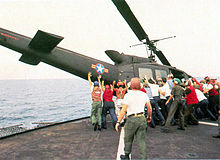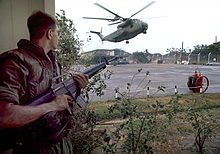Operation Frequent Wind
Vietnam War
Battle of Tua Hai (1960) - Battle of Ap Bac (1963) - Battle of Nam Dong (1964) - Tonkin Incident (1964) - Operation Flaming Dart (1965) - Operation Rolling Thunder (1965-68) - Battle of Dong Xoai (1965) - Battle of the Ia Drang Valley (1965) - Operation Crimp (1966) - Operation Hastings (1966) - Battle of Long Tan (1966) - Operation Attleboro (1966) - Operation Cedar Falls (1967) - Battle around Hill 881 (1967) - Battle of Dak To (1967) - Battle of Khe Sanh (1968) - Tet Offensive (1968) - Battle of Huế (1968) - Operation Speedy Express (1968/69) - Operation Dewey Canyon ( 1969) - Battle of Hamburger Hill (1969) - Operation MENU (1969/70) - Operation Lam Son 719 (1971) - Battle of FSB Mary Ann (1971) - Battle of Quảng Trị (1972) - Operation Linebacker (1972) - Operation Linebacker II (1972) - Battle of Xuan Loc (1975) - Operation Frequent Wind (1975)

Operation Frequent Wind was the American evacuation of the South Vietnamese capital Saigon on April 29 and 30, 1975 during the final phase of the Vietnam War .
prehistory

In the weeks before the evacuation , when given the offensive of the North already apparent that the war, which had Pentagon 50 ships of the US Navy , including four aircraft carriers , and 150 naval aircraft and 6,000 US Marines moved into the region, supported by 120 aircraft of the United States Air Force , mostly tankers and hunters , on bases in Thailand were stationed. The security adviser of US President Gerald Ford , Henry Kissinger , and the US ambassador in Saigon , Graham Martin , refused an early evacuation of US personnel, fearing that it would come under the Vietnamese civilians into a panic.
Nevertheless, as of April 21, around 40,000 Americans and Vietnamese, mostly members of the military and government, had already been flown out by plane from Tan Son Nhut Air Base near Saigon, plus around 2,000 orphans . Due to the advance of the North Vietnamese People's Army , the air force base came under artillery and rocket fire on the morning of April 28. The base was closed, further flights were impossible. In addition, South Vietnamese civilians stormed the base to flee the country from the advancing communists. President Ford, who was in session with his energy and economic advisers, was notified and scheduled a meeting of the national security committee . After discussing the situation, he ordered the evacuation by helicopter at 10:45 p.m.
procedure

The aircraft carriers ( USS Hancock , USS Midway , USS Coral Sea and USS Enterprise ) and the helicopter carrier Okinawa were stationed off the coast of Vietnam to serve as the landing base for the helicopters made available by the 9th Marine Amphibious Brigade. The area of the US embassy and the area of the Defense Attaché Office in Saigon were chosen as landing sites , which were walled and easier to control.
By the evening of April 28, the helicopter evacuation of US personnel from Tan Son Nhut Air Force Base was completed, but embassy personnel were still waiting in the crowded US embassy in central Saigon. The evacuation began on the morning of April 29th when the radio stations played the song White Christmas , which had been arranged as a signal. Within just three hours, 72 evacuation flights started from the US embassy to the ships off the coast, from the site of military attaché building 122. Many of the helicopters were completely overloaded, as numerous civilians entered the area despite the guards and the helicopters stormed.
At the same time, more than 100 aircraft of the South Vietnamese Air Force , including several fully loaded transport planes, but also fighter bombers and fighter planes , landed on the Utapao Air Force Base in Thailand. This brought about 2,000 more refugees to those who had been on the base for a long time. This prompted the Thai government to issue the ultimatum that the refugees would have to leave the country or be taken out of the country within 30 days and that the military equipment would be "handed over to the next government in Saigon".
Many South Vietnamese helicopter crews also headed for the US ships off the coast and landed there, and two O-1 Birddog reconnaissance aircraft landed on the midway . Many of the aircraft were thrown overboard as they blocked the landing areas. The images of South Vietnamese UH-1 helicopters being pushed over the deck edge of the girders shape the image that remains of the end of the Vietnam War.
In 444 flights the US Air Force and the Marine Corps had evacuated 1,373 Americans and 5,595 refugees, mostly Vietnamese, onto the ships off the coast. In the weeks that followed, the refugees were transferred to the USA, some of which were also taken in by allied states such as Australia and New Zealand.
During the operations, a CH-46 SeaKnight crashed over the sea. Two of the four crew members were rescued, the other two, Captain William C. Nystul and First Lieutenant Michael J. Shea, are missing and are the last US soldiers missing during the Vietnam War.
Media reception
A photograph taken by the Dutch photojournalist Hubert van Es for the United Press International photo agency is a symbol of the American escape . It shows an Air America Bell UH-1 helicopter picking up refugees on the roof of a house. It is part of a series of images that, contrary to popular belief, were not taken on the US embassy grounds, but on the roof of an apartment complex on Gia-Long-Strasse used by the CIA.
Ships involved
At the Operation Frequent Wind participating ships of the US Navy:
Web links
- Lost Movie Treasures : S02 E10: The Fall of Saigon (Documentary Series)
Individual evidence
- ↑ a b c Operation Frequent Wind. (No longer available online.) Fallofsaigon.org, archived from the original on November 22, 2010 ; accessed on August 15, 2019 .
- ↑ a b Operation Frequent Wind Calls for Saigon Evacuation. (No longer available online.) Coldwarfiles.com, April 29, 1975, archived from the original on September 28, 2007 ; accessed on August 15, 2019 .
- ^ Helicopter Evacuating Crowd from Rooftop. (No longer available online.) Corbisimages.com, archived from the original on April 2, 2016 ; accessed on August 15, 2019 .
- ↑ This is an archived page. What the author saw, April 29, 1975. nytimes.com ( New York Times ), April 29, 2005, accessed August 15, 2019 .
- ^ Fox Butterfield, with Kari Haskell: The World; Getting It Wrong in a Photo. nytimes.com ( New York Times ), April 23, 2000, accessed August 15, 2019 .
- ^ Operation "Frequent Wind", Evacuation of Saigon, South Vietnam. (No longer available online.) Bouwman.com, archived from the original on July 21, 2019 ; accessed on August 15, 2019 .

